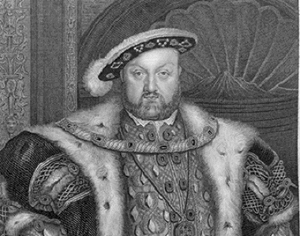With Tudor Times we profile a different figure every month. Here, Melita Thomas explores the dramatic life of Henry VIII’s sister, Margaret Tudor.

Margaret, daughter of Henry VII and Elizabeth of York, lived a life as eventful as that of her more famous brother, King Henry VIII. Married three times, she lost her first husband to her brother’s army, had her second marriage annulled, and tried to leave her third husband. She fought for her position as Regent of Scotland, and intrigued with both the English and French to maximise her chance of retaining power. Recently the subject of fiction, it is hard to imagine a life more dramatic than the truth.
Born at Westminster, Margaret was her parents’ second child. Her arrival was seen as a continuing sign of God’s favour to a king whose claim to the throne was not strong, but who was making every effort to promote himself as heir to the ancient King of the Britons, Arthur. Margaret was expected to play her part in establishing the legitimacy of the Tudor dynasty.
The princess’ first public appearance was just before her fifth birthday, when she presided as lady of honour at jousts celebrating the investiture of her younger brother, Henry, as Duke of York. Margaret watched the stylised, but still dangerous, combat, chose the winners and presented the glittering prizes.
Other than a few terrifying days in 1497, when rebels marched on London, and Queen Elizabeth and her children took refuge in the Tower of London, Margaret’s childhood was probably happy. From the evidence in the King’s and Queen’s account books, they loved their children and spent freely on them – particularly on musical instruments and, for Margaret, lavish clothes. On one occasion, Elizabeth paid to have Margaret’s orange sarcenet sleeves, left behind in a move, fetched.

Nevertheless, Margaret had a duty to perform – marriage to secure an alliance. When she was 10, negotiations began for her to marry James IV of Scotland to secure a ‘perpetual peace’ between countries that had been warring intermittently for centuries.
Rather than dispatching his daughter at 12, the legal age for marriage, Henry listened to the concerns of his mother and wife, and postponed it until she was physically more mature. Sadly, by the time Margaret, aged 13, set out with her father on her long journey to her new kingdom, she had lost her mother, and two brothers, Arthur, and Edmund. Only Henry, Duke of York, and a sister, Mary, were left.
Margaret’s journey to Scotland took nearly a month – trumpets announced her arrival in every town, as bells rang out from the steeples. In early August, King James, aged thirty, met her at Dalkeith Castle and spent the few days before the wedding making every effort to be kind to his little bride, so that by the time they were married on 8 August 1503, they had discovered a taste for music in common. Immediately after the wedding, Margaret was crowned Queen of Scots in Holyrood Abbey.
For 10 years, king and queen lived in harmony, although, distressingly, they lost three babies before a surviving son, also named James, was born in April 1512. The deaths of her children were not Margaret’s only sorrow. When her brother succeeded to the throne as Henry VIII, relations between England and Scotland broke down and Scotland could not avoid being drawn into the escalating conflict between its oldest ally, France, and England.
Mediation having failed, James felt obliged to assist Louis XII in the face of Henry’s invasion. The Scottish king crossed into England and was killed in a massive defeat at the Battle of Flodden.
Twenty-three-year-old Margaret, shortly to bear another son, had been named as regent for her young son, and she immediately organised his coronation. There was some murmuring at the thought of an English woman as regent, but she was accepted until she married the Earl of Angus, after which she was deposed.
The new regent was the pro-French Duke of Albany. As he was the next heir, Margaret feared that her sons were in danger, but after being besieged in Stirling Castle, she was obliged to surrender them. Doubting her own safety, she fled to England, where she bore Angus a daughter.
After a year at the English court, her return was agreed. During her absence, Angus had been living with another woman, and despite pleas from Angus and orders from Henry, Margaret would not forgive him.
The next few years saw a bewildering series of manoeuvres as Albany and Angus vied for supremacy, Margaret generally supporting Albany. In 1524, James was proclaimed of age, and Albany left Scotland. Angus, in a swift move, captured the king and until James wrested control in 1527, dominated government.
Margaret petitioned for an annulment of her marriage, which was granted, much to the anger of Henry VIII. She immediately married Henry Stewart, Lord Methven, with whom she had been living.
Margaret continued to advise James, always promoting improved relations with England, hoping for a match between James and her niece, Mary, at that time Henry VIII’s only heir. James however, favoured France, and sought his wife there.
In 1536, when Margaret discovered that Methven, too, was unfaithful, began annulment proceedings but James forbade it. Nevertheless, he and his queen, Marie of Guise, treated Margaret lovingly, turning to her in their grief when they lost their sons. The stress of this event may have contributed to a deterioration in Margaret’s health, and she died of a stroke on 18 October, 1541.
Related articles
|
Click here to subscribe! |






 © 2024
© 2024